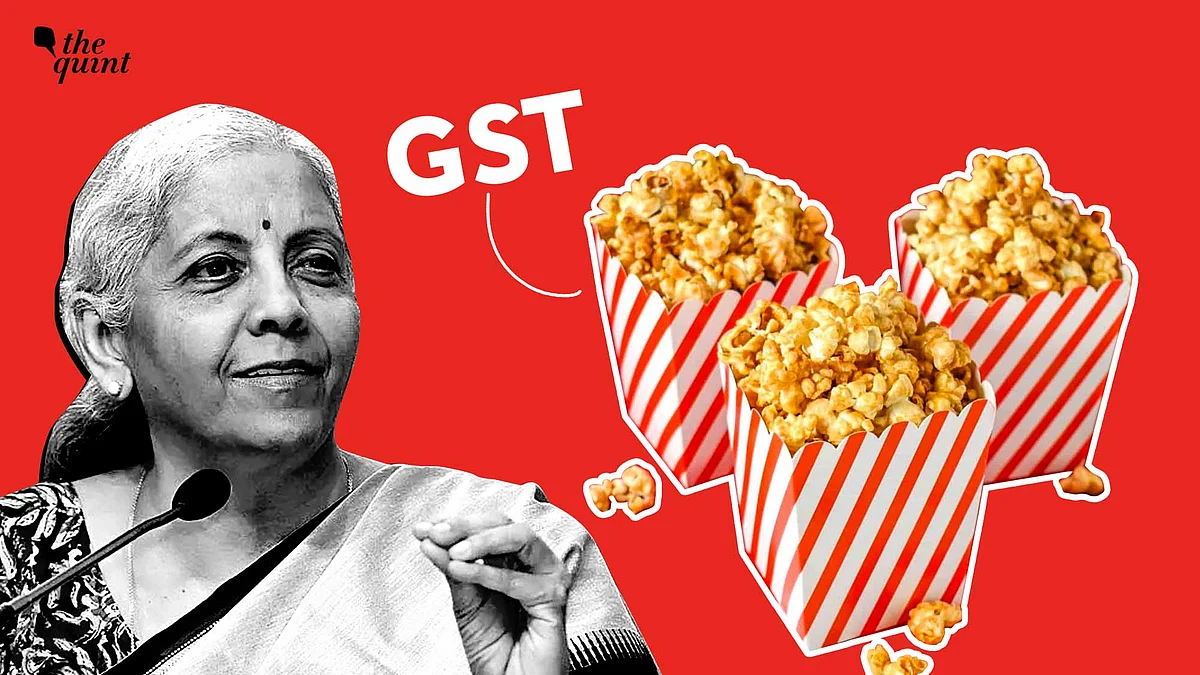
GST on Caramel Popcorn: The Weird Follies of an Imperfect Indirect Tax Regime
Nirmala Sitharaman's explanation on the GST rates on different types of popcorn has sparked a lot of online debate.

advertisement
India’s first Goods and Services Tax (GST) regime with the aim of unifying and simplifying the nation’s complex indirect tax structure was introduced by the Narendra Modi government in July 2017.
While in principle it will progressively streamline indirect taxes over time, the GST system has presented significant challenges for various sectors, including the restaurant industry.
Indeed, a matter involving buns and cream and a famous Coimbatore restaurant chain left the state's Bharatiya Janata Party (BJP) with egg on its face. More about that here.
The disparity in the taxation of raw and processed food products.
(Photo: The Quint)
Decoding the Issue of Multiple Tax Slabs Facing Restaurants
The GST regime in India operates on multiple tax slabs, primarily five percent, 12 percent, 18 percent, and 28 percent, with different food products falling under these categories.
Basic raw ingredients like fresh vegetables, grains, and milk are either exempt or taxed minimally at five percent, while processed food products such as pre-packaged meals, sauces, and condiments attract much higher rates, ranging from 12 percent to 28 percent.
The disparity in the taxation of raw and processed food products.
(Photo: The Quint)
The disparity in the taxation of raw and processed food products.
(Photo: The Quint)
For restaurants, GST is levied at two standard rates:
Five percent for restaurants that do not claim input tax credit (ITC)
18 percent for restaurants that claim ITC
While this simplifies the taxation structure for restaurants, the aforementioned variation in the GST rates creates complexities.
Restaurants rely heavily on a mix of raw ingredients and processed or semi-processed food products to manage kitchen efficiency and provide a wide array of dishes.
This raises overall operating expenses, which are often passed on to consumers through higher menu prices. Furthermore, this price escalation can hurt smaller, quick-service restaurants or chains. These higher costs can erode profit margins or necessitate frequent price increases, ultimately affecting customer retention.
Restaurants, especially those in fast food and quick-service categories, depend on processed ingredients to maintain speed, standardisation, and convenience. The GST disparity between raw and processed ingredients complicates supply chain management.
For example, a fast-food chain serving pizza might opt for pre-packaged sauces and toppings to maintain uniform taste across outlets. However, the high GST on these processed goods adds to their operating costs.
In contrast, a fine-dining restaurant that uses fresh ingredients sourced locally may benefit from lower tax rates but might also face more complex inventory management and preparation processes.
The impact of these GST disparities is felt more acutely by restaurants in urban areas compared to those in smaller cities or rural areas as they depend more on processed and semi-processed food products due to the high demand for quick service and convenience.
In contrast, restaurants in Tier-II and Tier-III cities may have more access to fresh, locally sourced raw ingredients, which are either tax-exempt or attract minimal GST. This reduces their cost burden and allows them to price their menu items more competitively compared to their urban counterparts.
What Can Be Done
To mitigate these challenges, the following reforms could be considered:
Reducing GST on Essential Processed Foods: Lowering the tax rates on minimally processed and essential food products commonly used by restaurants
Simplification of ITC Utilisation: Streamlining the ITC system for restaurants could help them maximise the benefits of GST credit, especially when they procure a mix of tax-free raw ingredients and higher-taxed processed products
Encouraging Locally Sourced Ingredients: Incentives for restaurants that source locally grown, fresh ingredients could promote the use of raw materials with lower GST rates, helping reduce operational costs while supporting local farmers
Reforms in the GST structure, particularly for processed food products, could help create a more level-playing field for restaurants, improve operational efficiency, and ensure that dining out remains an affordable option for consumers across the country.
(This article has been updated to reflect the recent controversy over the GST rates on different types of popcorn. It was first published in September 2024.)
(Deepanshu Mohan is a Professor of Economics, Dean, IDEAS, Office of Inter-Disciplinary Studies, and Director of Centre for New Economics Studies (CNES), OP Jindal Global University. He is a Visiting Professor at the London School of Economics, and a 2024 Fall Academic Visitor to the Faculty of Asian and Middle Eastern Studies, University of Oxford. Aryan Gopalakrishnan is a Research Analyst with CNES and graduated from Jindal School of Government and Public Policy. This is an opinion article and the views expressed above are the author’s own. The Quint neither endorses nor is responsible for them.)
- Access to all paywalled content on site
- Ad-free experience across The Quint
- Early previews of our Special Projects
Published: 17 Sep 2024,10:45 AM IST